Text
youtube
Will I be able to return to my normal activities after knee replacement surgery | Best Joint Replacement Surgeon in RR Nagar | Dr. Basavaraj CM
Dr. Basavaraj CM | Best Orthopedic Surgeon in RR Nagar | Are you considering knee replacement surgery but are worried about your ability to return to your normal activities after the procedure? Rest assured that with proper care and rehabilitation, most patients are able to resume their regular activities following knee replacement surgery.
For more information visit: https://www.drbasavaraj.com/
#osteoarthritis#osteoarthritisawareness#kneeosteoarthritis#osteoarthritistreatment#osteoarthritisknee#osteoarthritispain#DrBasavarajCm#OrthopaedicSurgeon#RRNagar#bangalore#Youtube
0 notes
Text
youtube
Do I need a knee replacement | Best Joint Replacement Surgeon in RR Nagar | Dr. Basavaraj CM
Dr. Basavaraj CM | Best Orthopaedic Surgeon in RR Nagar | In this video, we'll discuss the signs and symptoms that indicate you may need a knee replacement. By the end of this video, you'll have a better understanding of the signs and symptoms that indicate you may need a knee replacement and what to expect during the consultation process.
For more information visit: https://www.drbasavaraj.com/
#osteoarthritis#osteoarthritisawareness#kneeosteoarthritis#osteoarthritistreatment#osteoarthritisknee#osteoarthritispain#Youtube
0 notes
Text
Treatment options for arthritis | Best Joint Replacement Surgeon in RR Nagar Bangalore | Dr. Basavaraj CM
Dr. Basavaraj CM | Best Orthopaedic Surgeon in RR Nagar | In this video, we'll discuss the different types of arthritis treatments available, including medication, physical therapy, weight management, and lifestyle changes. By the end of this video, you'll have a better understanding of the different treatment options available and how to manage your arthritis symptoms effectively.
Best Orthopaedic Surgeon in RR Nagar, Best joint replacement surgeon in RR Nagar, Best Orthopaedic Surgeon in RR Nagar Bangalore, Best Hip Replacement Surgeon in RR Nagar, Bangalore, Best Doctors for Hip Replacement Surgery
#osteoarthritis #osteoarthritisawareness #kneeosteoarthritis #osteoarthritistreatment #osteoarthritisknee #osteoarthritispain
0 notes
Text
youtube
When should I consult a doctor about knee pain from arthritis? | Best Joint Replacement Surgeon in RR Nagar Bangalore | Dr. Basavaraj CM
Dr. Basavaraj CM | Best Orthopaedic Surgeon in RR Nagar | If you're experiencing knee pain from arthritis and wondering whether you should see a doctor, this video is for you. We'll help you understand when it's time to seek medical attention and what to expect during your visit.
Best Orthopedic Surgeon in RR Nagar, Best joint replacement surgeon in RR Nagar, Best Orthopedic Surgeon in RR Nagar Bangalore, Best Hip Replacement Surgeon in RR Nagar, Bangalore, Best Doctors for Hip Replacement Surgery
#osteoarthritis#osteoarthritisawareness#kneeosteoarthritis#osteoarthritistreatment#osteoarthritisknee#osteoarthritispain#Youtube
0 notes
Text
youtube
Could my knee pain from arthritis | Best Joint Replacement Surgeon in RR Nagar, Bangalore | Dr. Basavaraj CM In this video, Dr. Basavaraj CM | Best Orthopedic Surgeon in RR Nagar answer one of the important questions regarding knee pain?
Watch this video for more details
#Best Orthopaedic Surgeon in RR Nagar#Best joint replacement surgeon in RR Nagar#Best Orthopaedic Surgeon in RR Nagar Bangalore#Best Hip Replacement Surgeon in RR Nagar#Bangalore#Best Doctors for Hip Replacement Surgery#osteoarthritis#osteoarthritisawareness#kneeosteoarthritis#osteoarthritistreatment#osteoarthritisknee#osteoarthritispain#Youtube
1 note
·
View note
Text
Dr. Talk On Knee Stiffness | Best Joint Replacement Surgeon in RR Nagar, Bangalore | Dr. Basavaraj CM Best Orthopedic Surgeon in RR Nagar, Bangalore |
Dr. Basavaraj CM says Knee stiffness is a common symptom that affects many people, especially those who engage in physical activities or suffer from knee injuries or medical conditions. In this video, we will answer a common question what does stiffness in my knee mean?
Best Orthopedic Surgeon in RR Nagar, Best joint replacement surgeon in RR Nagar, Best Orthopedic Surgeon in RR Nagar Bangalore, Best Hip Replacement Surgeon in RR Nagar, Bangalore, Best Doctors for Hip Replacement Surgery
0 notes
Text
Dr. Talk On Understanding Osteoarthritis | Best Orthopaedic Surgeon in RR Nagar, Bangalore | Dr.Basavaraj CM
Best Orthopedic Surgeon in RR Nagar, Bangalore | Dr. Basavaraj CM says Osteoarthritis is a common joint disorder that affects millions of people worldwide, particularly in older age. In this video, we will delve into the causes and risk factors associated with osteoarthritis, as well as its symptoms and how it is diagnosed. We will also discuss various treatment options available to manage this condition. Watch Now to know more about Osteoarthritis.
0 notes
Text
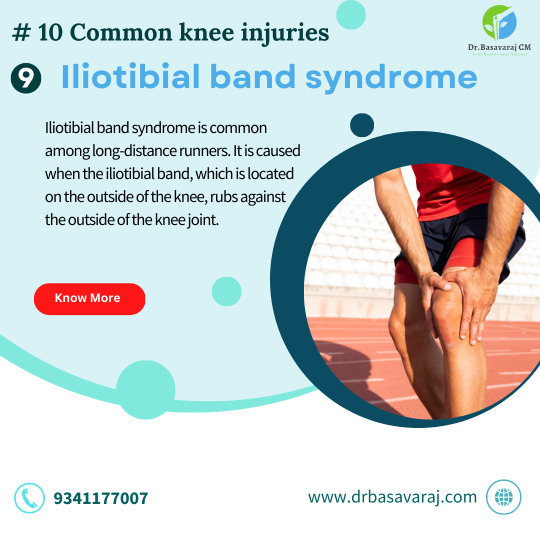
Iliotibial band syndrome Program by Best Orthopedic Surgeon in RR Nagar | Dr. Basavaraj CM
Description: Iliotibial band syndrome is a type of ligament that connects two bones on either side of a joint, providing stability and limiting excessive sideways motion. There are two collateral ligaments in each knee joint - the Iliotibial band syndrome and the lateral collateral ligament (LCL). The MCL runs along the inner side of the knee joint, connecting the thigh bone (femur) to the shin bone (tibia), while the LCL runs along the outer side of the knee joint, connecting the thigh bone to the smaller bone in the lower leg (fibula).
Iliotibial band syndrome (ITBS), also known as iliotibial band friction syndrome, is a common overuse injury that affects the outer side of the knee. The iliotibial band is a thick band of fascia that runs from the pelvis to the knee, providing stability to the knee joint during movement.
Iliotibial band syndrome (ITBS) is a common overuse injury that affects many athletes, particularly runners, and cyclists. It is caused by the repetitive bending and straightening of the knee, which results in irritation and inflammation of the iliotibial band (ITB). The ITB is a thick band of fascia that runs from the hip to the knee, providing stability to the knee joint during movement.
Symptoms of ITBS typically include pain and tenderness on the outer side of the knee, which is often described as a sharp or burning sensation. The pain may be most noticeable during activities that involve repetitive bending and straightening of the knee, such as running, cycling, or climbing stairs. In some cases, swelling or tightness may also be present in the area.
Several risk factors have been identified for ITBS, including a sudden increase in training volume or intensity, poor footwear, muscle imbalances or weakness in the hip or thigh muscles, and biomechanical issues such as overpronation or leg length discrepancy. ITBS can also be aggravated by running on uneven surfaces or downhill, or by running with improper form.
The treatment for ITBS typically involves rest, ice, and anti-inflammatory medications to reduce pain and inflammation. Physical therapy may also be recommended to address any underlying muscle imbalances or weakness, and to improve flexibility and strength in the hip and thigh muscles. In some cases, corticosteroid injections may be necessary to relieve severe pain or inflammation. Surgery is rarely needed for ITBS, but it may be considered in cases of severe or chronic ITBS that do not respond to other treatments.
Prevention strategies for ITBS include proper warm-up and cool-down, wearing appropriate footwear, gradually increasing training volume and intensity, and maintaining proper form during exercise. Stretching and strengthening exercises for the hip and thigh muscles can also help to prevent ITBS. It is important to listen to your body and to rest if you feel any pain or discomfort while exercising. By taking these steps, you can reduce your risk of developing ITBS and stay healthy and active.
During activities that involve repetitive bending and straightening of the knee, such as running or cycling, the iliotibial band can become irritated and inflamed as it rubs against the lateral femoral epicondyle (the bony bump on the outer side of the knee). This leads to pain and discomfort on the outer side of the knee, often described as a sharp or burning sensation.
Common symptoms of ITBS include pain and tenderness on the outer side of the knee, especially during activities that involve repetitive bending and straightening of the knee. The pain may also be present when descending stairs or hills. In some cases, swelling or tightness in the area may also be present.
Risk factors for ITBS include a sudden increase in training volume or intensity, poor footwear, muscle imbalances or weakness in the hip or thigh muscles, and biomechanical issues such as overpronation (inward rolling of the foot) or leg length discrepancy.
Treatment for ITBS typically involves rest, ice, and anti-inflammatory medications to reduce pain and inflammation. Physical therapy may also be recommended to address any underlying muscle imbalances or weakness, and to improve flexibility and strength in the hip and thigh muscles. In severe cases, corticosteroid injections or surgery may be necessary. Prevention strategies include proper warm-up and cool-down, wearing appropriate footwear, gradually increasing training volume and intensity, and maintaining proper form during exercise.
For more info visit- https://www.drbasavaraj.com/
Iliotibial band syndrome #kneeinjuries #ortho #knee #ortopedia #surgeon #injury #physicaltherapy #healthcare #medical #health #surgery #injury #rehabilitation #Iliotibial band #syndrome#SportsInjury #MusculoskeletalInjury #Orthopedics #PhysicalTherapy #Rehabilitation #SportsMedicine #Trauma #ChronicPain #Mobility #InjuryPrevention #MedicalAdvice #Fitness #HealthyLiving #Wellness
0 notes
Text

Collateral Ligament | Best Orthopedic Surgeon in RR Nagar | Dr. Basavaraj CM
A collateral ligament is a type of ligament that connects two bones on either side of a joint, providing stability and limiting excessive sideways motion. There are two collateral ligaments in each knee joint — the medial collateral ligament (MCL) and the lateral collateral ligament (LCL). The MCL runs along the inner side of the knee joint, connecting the thigh bone (femur) to the shin bone (tibia), while the LCL runs along the outer side of the knee joint, connecting the thigh bone to the smaller bone in the lower leg (fibula).
0 notes
Text

Collateral Ligament | Best Orthopedic Surgeon in RR Nagar | Dr. Basavaraj CM
#Collateral Ligament#kneeinjuries#ortho#knee#ortopedia#surgeon#injury#physicaltherapy#healthcare#medical#health#surgery#rehabilitation#SportsInjury#MusculoskeletalInjury#Orthopedics#PhysicalTherapy#Rehabilitation#SportsMedicine#Trauma#ChronicPain#Mobility
0 notes
Text
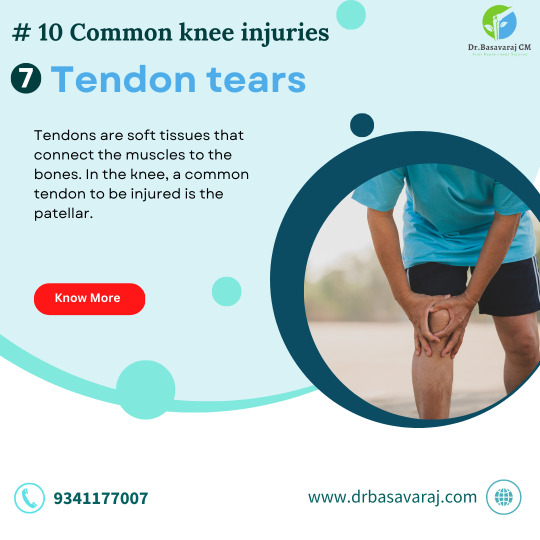
A tendon tear, also known as a tendon rupture, occurs when a tendon, which is a tough band of fibrous connective tissue that connects muscles to bones, partially or completely separates from the bone or muscle it is attached to. Tendon tears most commonly occur in the tendons of the shoulder, elbow, knee, and ankle.
Tendon tears can be caused by a sudden injury, such as a fall or a direct blow to the affected area, or by repetitive stress and overuse, which can gradually weaken the tendon over time. People who engage in sports or physical activities that involve sudden, forceful movements or repetitive motions, such as tennis, basketball, or running, are at a higher risk for tendon tears.
The symptoms of a tendon tear may include sudden and severe pain at the site of the tear, swelling, bruising, weakness or stiffness in the affected area, and difficulty moving the joint or muscle that the torn tendon is connected to. In some cases, a person may also hear or feel a popping or snapping sensation at the time of injury.
Treatment for a tendon tear depends on the severity and location of the tear, as well as the individual's overall health and activity level. Mild tendon tears may be treated with rest, ice, and pain medications, while more severe tears may require surgery to repair the damaged tendon.
Rehabilitation and physical therapy are often recommended after treatment to help restore strength, flexibility, and range of motion to the affected area. With proper treatment and rehabilitation, many people are able to recover from a tendon tear and return to their normal activities.
For more info visit- https://www.drbasavaraj.com/
Tendon tear #kneeinjuries #ortho #knee #ortopedia #surgeon #injury #physicaltherapy #healthcare #medical #health #surgery #injury #rehabilitation #TendonTear #TendonRupture #SportsInjury #MusculoskeletalInjury #Orthopedics #PhysicalTherapy #Rehabilitation #SportsMedicine #Trauma #ChronicPain #Mobility #InjuryPrevention #MedicalAdvice #Fitness #HealthyLiving #Wellness
0 notes
Text
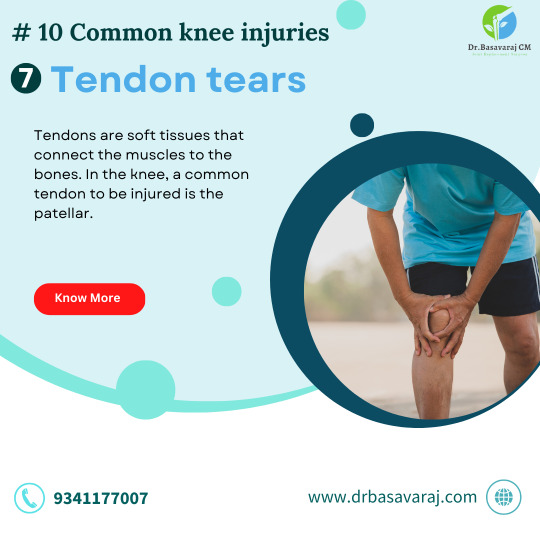
Tendon tear | Best Orthopedic Surgeon in RR Nagar | Dr. Basavaraj CM
A tendon tear, also known as a tendon rupture, is an injury that occurs when a tendon, which connects a muscle to a bone, is partially or completely torn. This injury can cause pain, swelling, stiffness, and limited mobility in the affected area. Treatment for a tendon tear depends on the severity and location of the tear and may involve rest,, physical therapy, or surgery. Prompt and appropriate care can help improve outcomes and reduce the risk of long-term complications.
#Tendon tear#kneeinjuries#ortho#knee#ortopedia#surgeon#injury#physicaltherapy#healthcare#medical#health#surgery#rehabilitation#TendonTear#TendonRupture#SportsInjury#MusculoskeletalInjury#Orthopedics#PhysicalTherapy#Rehabilitation#SportsMedicine#Trauma#ChronicPain#Mobility#InjuryPrevention#MedicalAdvice#Fitness#HealthyLiving#Wellness
0 notes
Text
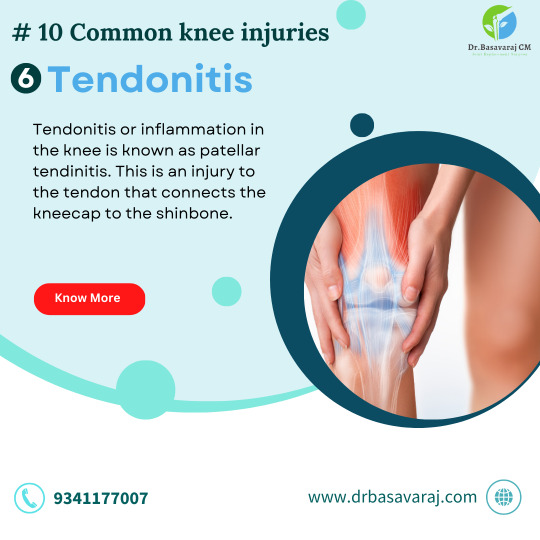
Tendonitis | Best Orthopedic Surgeon in RR Nagar | D.r Basavaraj CM
Yes, in today’s scenario, the number of joint replacement surgery have increased and at the same time, the number of patients benefitting from this joint replacement surgery has also increased. But it does not mean that all types of knees or joint pain are recommended for joint replacement surgery.
tendonitis is a condition that occurs when a tendon, which is a thick cord that attaches muscle to bone, becomes inflamed or irritated. Tendons are responsible for transmitting the force of muscle contractions to bones, and they can become damaged due to overuse or injury.
The symptoms of tendonitis include pain, tenderness, stiffness, and swelling in the affected area. The condition can be acute or chronic, and it can occur in any tendon in the body, although it is most common in the shoulders, elbows, wrists, knees, and ankles.
Treatment for tendonitis typically involves rest, ice, compression, and elevation (RICE) to reduce pain and inflammation. Nonsteroidal anti-inflammatory drugs (NSAIDs) may also be used to relieve pain and reduce swelling. Physical therapy or exercises to stretch and strengthen the affected tendon may be recommended to promote healing and prevent future injury. In some cases, a brace or other supportive device may be prescribed to help immobilize the affected area and allow it to heal. In severe cases, surgery may be necessary to repair a damaged tendon.
For more info visit- https://www.drbasavaraj.com/
tendonitis #kneeinjuries #ortho #knee #ortopedia #surgeon #injury #physicaltherapy #healthcare #medical #health #surgery #injury #rehabilitation #health #surgery #injury #rehabilitation #recovery #rehab #knee
0 notes
Text
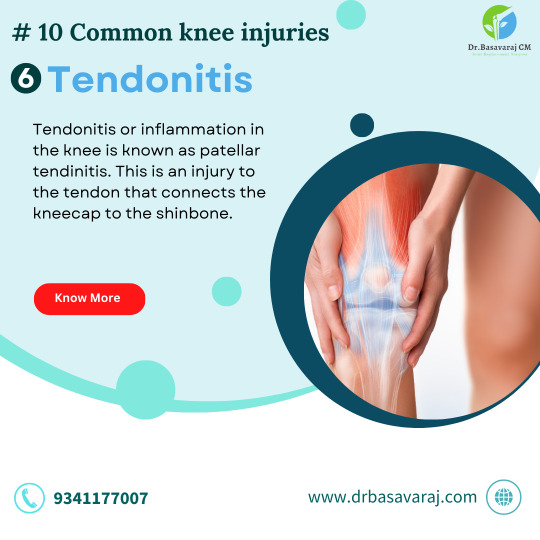
Tendonitis | Best Orthopedic Surgeon in RR Nagar | Dr. Basavaraj CM
Yes, in today’s scenario, the number of joint replacement surgery have increased and at the same time, the number of patients benefitting from this joint replacement surgery has also increased. But it does not mean that all types of knees or joint pain are recommended for joint replacement surgery.
tendonitis is a condition that occurs when a tendon, which is a thick cord that attaches muscle to bone, becomes inflamed or irritated. Tendons are responsible for transmitting the force of muscle contractions to bones, and they can become damaged due to overuse or injury.
The symptoms of tendonitis include pain, tenderness, stiffness, and swelling in the affected area. The condition can be acute or chronic, and it can occur in any tendon in the body, although it is most common in the shoulders, elbows, wrists, knees, and ankles.
Treatment for tendonitis typically involves rest, ice, compression, and elevation (RICE) to reduce pain and inflammation. Nonsteroidal anti-inflammatory drugs (NSAIDs) may also be used to relieve pain and reduce swelling. Physical therapy or exercises to stretch and strengthen the affected tendon may be recommended to promote healing and prevent future injury. In some cases, a brace or other supportive device may be prescribed to help immobilize the affected area and allow it to heal. In severe cases, surgery may be necessary to repair a damaged tendon.
For more info visit- https://www.drbasavaraj.com/
#Tendonitis#kneeinjuries#ortho#knee#ortopedia#surgeon#injury#physicaltherapy#healthcare#medical#health#surgery#rehabilitation#recovery#rehab#bangalore#rrnagar
0 notes
Text
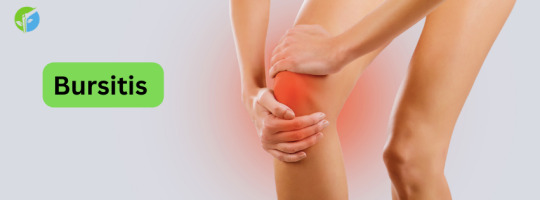
Bursitis | Best Orthopedic Surgeon in RR Nagar | Dr Basavaraj CM
Bursitis is a condition in which the bursae, small fluid-filled sacs located near joints, become inflamed. Bursae act as cushions between bones, tendons, and muscles, helping to reduce friction and facilitate movement. When they become inflamed, it can cause pain, stiffness, and tenderness around the affected joint.
The most common causes of bursitis include repetitive motions or overuse of a joint, injury or trauma, infection, and certain medical conditions such as rheumatoid arthritis and gout. Bursitis can occur in any joint, but it is most common in the shoulders, elbows, hips, and knees.
The symptoms of bursitis can include pain and tenderness around the affected joint, swelling and redness, stiffness and limited range of motion, and sometimes a fever. Treatment for bursitis usually involves resting the affected joint, applying ice to reduce swelling, taking over-the-counter pain relievers, and in some cases, receiving corticosteroid injections or undergoing physical therapy. In severe cases, surgery may be required to remove the inflamed bursa. It's important to seek medical attention if you experience symptoms of bursitis, as it can be a chronic condition if left untreated.
Bursitis is a medical condition that occurs when the bursae, small fluid-filled sacs located near joints, become inflamed. Bursae act as cushions between bones, tendons, and muscles, helping to reduce friction and facilitate movement. When they become inflamed, it can cause pain, tenderness, stiffness, and limited range of motion around the affected joint.
Bursitis can occur in any joint, but it is most common in the shoulders, elbows, hips, and knees. The most common causes of bursitis include repetitive motions or overuse of a joint, injury or trauma, infection, and certain medical conditions such as rheumatoid arthritis and gout.
The symptoms of bursitis can include pain and tenderness around the affected joint, swelling and redness, stiffness and limited range of motion, and sometimes a fever. These symptoms can range from mild to severe and can impact an individual's ability to perform daily activities.
Treatment for bursitis typically involves resting the affected joint, applying ice to reduce swelling, taking over-the-counter pain relievers, and in some cases, receiving corticosteroid injections or undergoing physical therapy. In severe cases, surgery may be required to remove the inflamed bursa.
If you experience symptoms of bursitis, it's important to seek medical attention. With proper treatment, most people with bursitis can recover and return to their normal activities.
Sure, here is some additional content on bursitis:
Causes:
Bursitis can be caused by a variety of factors including repetitive motions or overuse of a joint, injury or trauma, infection, and certain medical conditions such as rheumatoid arthritis and gout. Repetitive motions that involve the same joint or muscle group, such as those performed in sports or work-related activities, can irritate the bursae and cause inflammation. Injuries to the joint or infection can also cause bursitis to develop.
Risk factors:
Certain factors may increase the risk of developing bursitis, including age (as bursitis is more common in older adults), joint overuse, improper posture or technique during physical activity, and certain medical conditions such as rheumatoid arthritis, gout, and diabetes.
Diagnosis:
Diagnosis of bursitis typically involves a physical exam to assess the affected joint, including a check for swelling, tenderness, and range of motion. A doctor may also perform imaging tests such as X-rays, MRI, or ultrasound to evaluate the extent of the inflammation and rule out other possible causes of symptoms such as arthritis.
Treatment:
Treatment for bursitis typically involves rest and avoiding activities that aggravate the affected joint, applying ice to reduce swelling, taking over-the-counter pain relievers such as acetaminophen or nonsteroidal anti-inflammatory drugs (NSAIDs) such as ibuprofen, and possibly receiving corticosteroid injections to reduce inflammation. Physical therapy may also be recommended to improve joint mobility and reduce the risk of future bursitis flare-ups. In some cases, surgery may be necessary to remove the inflamed bursa.
Prevention:
To reduce the risk of developing bursitis, it is important to practice proper posture and technique during physical activity, take regular breaks when performing repetitive motions, and gradually increase the intensity and duration of physical activity to avoid overuse injuries. Using proper protective equipment, such as knee pads and elbow pads, can also help prevent bursitis in these areas. Maintaining a healthy weight and managing any underlying medical conditions can also reduce the risk of bursitis development.
0 notes
Text
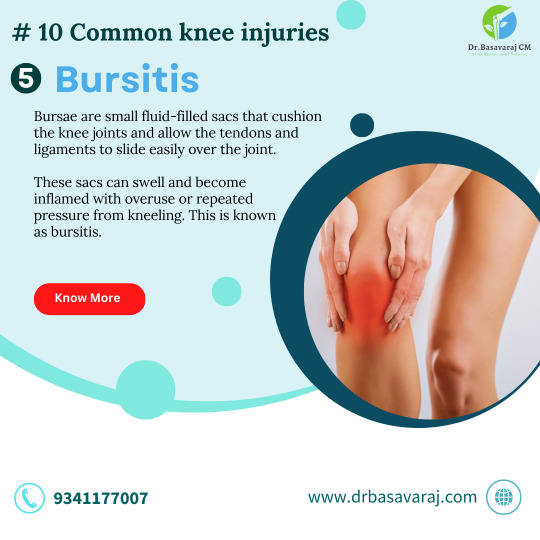
Bursitis | Best Orthopaedic Surgeon in RR Nagar | Dr Basavaraj CM
Bursitis is a condition in which the bursae, small fluid-filled sacs located near joints, become inflamed. Bursae act as cushions between bones, tendons, and muscles, helping to reduce friction and facilitate movement. When they become inflamed, it can cause pain, stiffness, and tenderness around the affected joint.
0 notes
Text
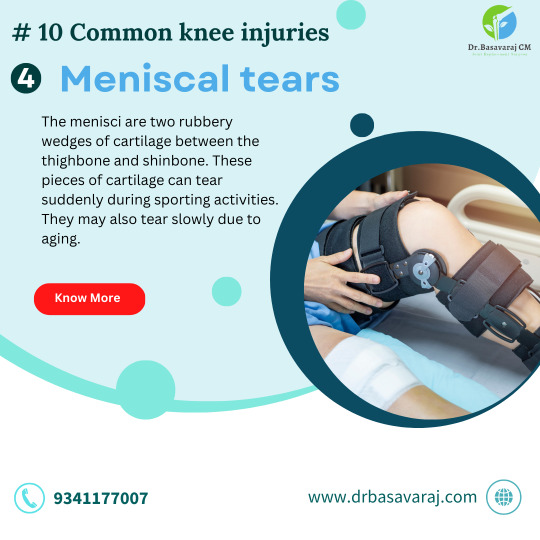
Meniscal Tears | Best Orthopaedic Surgeon in RR Nagar Bangalore | Dr. Basavaraj
Best Orthopedic Surgeon in RR Nagar |Dr. Basavaraj CM says Meniscal tears are a common knee injury that can cause significant pain and impact your daily activities. The meniscus is a crescent-shaped piece of cartilage in your knee that acts as a shock absorber and helps to distribute weight evenly across the joint. When this important structure is damaged, it can cause pain, swelling, and difficulty moving the knee.
#kneeinjuries#ortho#knee#ortopedia#surgeon#injury#physicaltherapy#healthcare#medical#health#surgery#rehabilitation#recovery#rehab#MeniscalTears#OrthopedicCare#RRNagar#Bangalore#DrBasavarajacm#KneePainRelief#MeniscusTreatment#OrthopedicSpecialist#KneeHealth#RehabilitationAndRecovery
0 notes